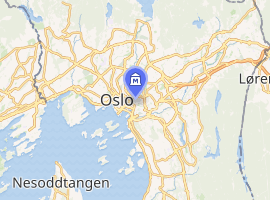Intercultural Museum
The Intercultural Museum in Oslo, Norway, was founded in 1990 by Bente Guro Møller. It is located at Tøyenbekken 5, in an old police station in the district of Grønland at the eastern side of downtown Oslo. The Intercultural Museum is a migration museum, and is primarily concerned with the collection, preservation and dissemination of Norwegian immigration history.

|
Mass immigration is a relatively recent phenomenon in Norway, starting for real with the influx of Pakistani migrant workers in the 1970s. The Intercultural Museum was established as a response to the immigration and the cultural changes it entailed. It has received much attention for its pioneer work with the new minority groups in Norway. In 2006, it was selected as "Museum of the Year" by the Norwegian Museums Association.
Since 2006, the Intercultural Museum has been part of the Oslo Museum.
The museum is open daily (except Mondays), and offers free entry to the main exhibits and the gallery of contemporary art. It also offers guided tours around Grønland, the historical "transit area" in downtown Oslo and one of the most obviously multicultural districts in the city.
Further reading
- Møller, B. G., & Einarsen, H. P. (2008). "As in a Mirror". In K. Goodknow & H. Akman, eds., Scandinavian Museums and Cultural Diversity. Oxford: Museum of London and Berghahn Books. pp. 140–45.
- Naguib, S.-A. (2013a). "La politique de la diversité dans un musée sans collection, l'Interkulturelt Museum d'Oslo". In D. Chevallier, ed., Métamorphoses des musées de société. Paris: La Documentation française. pp. 105–110.
- Naguib, S.-A. (2013b). "Museums, Diasporas and the Sustainability of Intangible Cultural Heritage". Sustainability 2013 (5), 2178–90.
- Varutti, M. (2011). "Gradients of Alterity: Museums and the Negotiation of Cultural Difference in Contemporary Norway". Arv - Nordic Yearbook of Folklore 67, 13–36.
- Öscan, G., ed. (2015). Norvegiska Romá – Norwegian Gypsies: One People – Many Voices. Oslo: Oslo Museum.